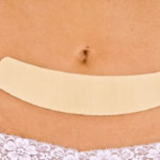You have no items in your shopping cart.
 If you’re planning to have a C-section or have recently had a C-section, you’re probably wondering what the scar will look like and what you can do to minimize the appearance of it. Many over-the-counter scar treatments exist, all claiming to reduce the appearance of your C-section scar. There are creams, lotions, oils, gels, patches, etc. - with all of these product options, it’s difficult to determine which treatment will work best. In order to solve this problem, below we’ve gathered evidence from clinical studies as well as expert opinions to determine what is the best treatment for C-section scars.
If you’re planning to have a C-section or have recently had a C-section, you’re probably wondering what the scar will look like and what you can do to minimize the appearance of it. Many over-the-counter scar treatments exist, all claiming to reduce the appearance of your C-section scar. There are creams, lotions, oils, gels, patches, etc. - with all of these product options, it’s difficult to determine which treatment will work best. In order to solve this problem, below we’ve gathered evidence from clinical studies as well as expert opinions to determine what is the best treatment for C-section scars.
C-SECTION INCISIONS
According to the Centers for Disease Control and Prevention (CDC), approximately one-third of all births in the United States are by C-section. During a C-section, the physician makes two incisions: one is through the skin of the lower abdomen and the second is into the uterus. The majority of C-sections are done with a low-transverse incision, which is a horizontal incision made across the lowest part of the uterus. The incision is usually around 4 to 6 inches.
While the incision on the uterus is always closed with dissolvable stitches, there are three different ways a physician can close the skin:
- Staples- Metal staples are used to close the incision This is a popular choice because it’s the easiest and quickest option.
- Stitches- A needle and thread are used to sew the incision together with stitches.
- Glue - Surgical glue is used to seal the incision and is covered with a transparent dressing. It has been reported that glue heals faster and leaves the least visible scar compared to the other options. However, many factors play into whether surgical glue can be used, such as the type of incision that was made and the consistency of your abdominal skin and fat.

C-SECTION SCARS
When the incision is healing, there’s a chance that the body’s natural healing process could go into overdrive, resulting in a raised, discolored scar. There are two ways to classify these types of scars: hypertrophic and keloid.
Hypertrophic scars are caused by the excess production of collagen during the wound healing process, resulting in a scar that is raised and red in appearance.
Keloid scars are also formed due to an uninhibited production of collagen, but the feature that distinguishes keloids from hypertrophic scars is their growth past the original scar boundary. These scars are raised, turn from red to brown, and often have a lumpy appearance. Left untreated, keloid scars can continue to thicken and grow indefinitely. Skin with darker pigmentation is more prone to keloid formation.
THE BEST TREATMENT FOR C-SECTION SCARS
C-section incisions, like all surgical incisions, will leave a scar. However, it is possible to improve the appearance of the scar so that it is barely noticeable. Along with proper wound care, the first step you can take to prevent unwanted scar formation is to start treatment early, as soon as 10 to 14 days after surgery. The key is to use a treatment that has been proven to be safe and efficacious in managing scars. The article “Overview of Surgical Scar Prevention and Management”, published in the Journal of Korean Medical Science details the options for treating post-surgery scars, including C-section scars.
For hypertrophic scars, treatments include topical silicone gel or silicone sheets, intralesional steroid injections, pressure therapy, laser treatments, and surgical excision.

In regards to keloid scars, topical silicone gel or silicone sheets, intralesional steroid injections, and surgical excision are also treatment options. Additionally, radiation therapy, and chemotherapy agents, such as 5-fluorouracil and bleomycin, can be used for keloid scars.
As you can see, most of the treatment options for C-section scars are invasive, except for silicone gel scar treatments. According to a publication in Molecular Medicine, “Topical silicone gel sheeting has been a well-established treatment for management of scars since its introduction in the early 1980s, and its therapeutic effects on predominantly hypertrophic scars have been well documented in the literature.” Since silicone gel has been proven to be a safe and effective scar treatment option, and also represents a non-invasive scar management approach, we consider silicone gel to be the best treatment for C-section scars.
NewGel+ has several silicone gel products designed to soften, flatten, and fade your scar. Case studies show that using NewGel+ C-section strips after any staples or stitches have been removed can help make your scar flat and soft while reducing redness, itchiness, tightness and pain.
July 13, 2017
























← Older Post Newer Post →
0 comments